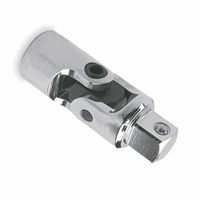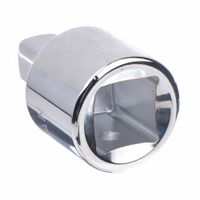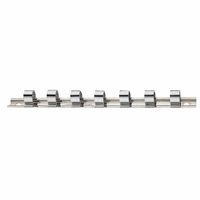Call +(254) 703 030 000 / 751 483 999 / 721 704 777
- Home
- Tools
- Sockets Bits
- Socket Adapters Extensions Accessories
- Hand Socket Adapters Extensions Accessories
.....Read More
Frequently Asked Questions
What is a hand socket adapter used for?
A hand socket adapter is a tool accessory used to connect sockets to power tools or hand tools, allowing for greater versatility and functionality. It serves as an intermediary between a socket and a tool, such as a ratchet, drill, or impact driver, enabling the user to drive or remove fasteners like nuts and bolts with ease.
The adapter typically features a square drive on one end that fits into the socket and a compatible shank or drive on the other end that attaches to the tool. This allows users to switch between different socket sizes and types without needing multiple tools, enhancing efficiency and convenience in various applications, from automotive repair to construction and home improvement projects.
Hand socket adapters come in various sizes and configurations, including different drive sizes (e.g., 1/4-inch, 3/8-inch, 1/2-inch) and types (e.g., hex, square), to accommodate a wide range of sockets and tools. Some adapters also offer features like swivel or universal joints, which provide flexibility and access to fasteners in tight or awkward spaces.
Overall, a hand socket adapter is an essential tool for anyone who frequently works with fasteners, offering adaptability, efficiency, and ease of use in various mechanical and DIY tasks.
How do socket extensions work?
Socket extensions, commonly known as power strips or extension cords, work by providing additional electrical outlets from a single wall socket, allowing multiple devices to be powered simultaneously. They consist of a flexible electrical cable with a plug on one end and a series of sockets on the other.
The plug is inserted into a wall outlet, establishing an electrical connection. The internal wiring of the extension cord distributes the electrical current from the plug to each of the sockets. This wiring is typically made of copper or aluminum, chosen for their excellent conductivity.
The sockets on the extension cord are designed to accommodate standard plugs, and they are usually equipped with safety features such as shutters to prevent accidental contact with live parts. Some socket extensions also include surge protectors, which safeguard connected devices from voltage spikes by diverting excess voltage to the ground.
Many socket extensions come with an on/off switch, allowing users to cut off power to all connected devices simultaneously. This feature can help save energy and protect devices from power surges.
The length of the cable and the number of sockets vary, providing flexibility in different settings. However, it's crucial to ensure that the total electrical load connected to the extension does not exceed its rated capacity, as this can lead to overheating and potential fire hazards.
In summary, socket extensions work by extending the reach and number of available electrical outlets, distributing power safely and efficiently to multiple devices while incorporating safety features to protect both the devices and users.
What are flex socket adapters?
Flex socket adapters are specialized tools used in conjunction with socket wrenches to provide enhanced flexibility and accessibility when working with fasteners in tight or awkward spaces. These adapters are designed to connect a socket to a ratchet or extension bar, allowing the socket to pivot or swivel at various angles. This flexibility is particularly useful in automotive repair, machinery maintenance, and other applications where direct access to a fastener is obstructed.
Typically, a flex socket adapter consists of a universal joint mechanism, which is a type of coupling that allows for rotational movement in multiple directions. This joint is usually made of durable materials like chrome vanadium steel to withstand the torque and stress applied during use. The design enables the socket to tilt and rotate, providing the user with the ability to reach fasteners that are not aligned with the tool's axis.
Flex socket adapters come in various drive sizes, such as 1/4-inch, 3/8-inch, and 1/2-inch, to match the drive size of the socket wrench being used. They are compatible with a wide range of sockets, making them versatile additions to any toolset. Some flex socket adapters also feature a locking mechanism to secure the socket in place, preventing it from slipping off during operation.
In summary, flex socket adapters are essential tools for enhancing the versatility and reach of socket wrenches, allowing users to efficiently tackle tasks in confined or obstructed areas. Their ability to pivot and swivel makes them invaluable for professionals and DIY enthusiasts alike, facilitating easier and more effective fastening and unfastening of bolts and nuts in challenging environments.
How do you organize tool sockets?
1. **Sort by Size**: Arrange sockets by size, from smallest to largest. This makes it easy to find the right size quickly.
2. **Group by Drive Size**: Separate sockets based on drive size (e.g., 1/4", 3/8", 1/2"). This helps in matching sockets with the correct ratchet.
3. **Use Socket Rails**: Utilize socket rails or holders to keep sockets in place. These can be magnetic, clip-on, or twist-lock, providing secure storage.
4. **Labeling**: Label each socket or its storage position with its size. This can be done using a label maker or permanent marker.
5. **Drawer Organizers**: Use drawer organizers or trays specifically designed for sockets. These often have pre-marked sizes and keep sockets neatly arranged.
6. **Magnetic Trays**: For a more flexible option, use magnetic trays that can hold sockets in place and be easily moved around.
7. **Wall-Mounted Racks**: If space allows, install wall-mounted racks to keep sockets visible and accessible.
8. **Foam Inserts**: Custom-cut foam inserts can be used in toolboxes or drawers to hold sockets securely and prevent them from rolling around.
9. **Color Coding**: Use color-coded bands or rings to quickly identify metric vs. SAE sockets or different drive sizes.
10. **Regular Maintenance**: Periodically check and reorganize sockets to ensure they are in the correct order and none are missing.
11. **Dedicated Socket Set Cases**: Keep sockets in their original cases if they come with one, as these are often designed for optimal organization.
12. **Digital Inventory**: Maintain a digital inventory of your sockets to track what you have and what might be missing.
What sizes do socket adapters come in?
Socket adapters come in a variety of sizes to accommodate different socket and drive sizes. The most common drive sizes for socket adapters are:
1. **1/4-inch Drive**: These are typically used for smaller sockets and are suitable for light-duty applications. They are often used in precision work and for small fasteners.
2. **3/8-inch Drive**: This is a versatile size that is commonly used in automotive and household applications. It provides a good balance between size and strength.
3. **1/2-inch Drive**: These are used for medium to heavy-duty applications. They are common in automotive repair and construction work, where more torque is required.
4. **3/4-inch Drive**: These are used for heavy-duty applications and are often found in industrial settings. They are suitable for large fasteners and high-torque applications.
5. **1-inch Drive**: These are used for very heavy-duty applications, such as in heavy machinery and industrial equipment. They can handle very high torque levels.
Socket adapters can also come in various configurations, such as:
- **Reducer Adapters**: These allow you to use a smaller socket on a larger drive tool. For example, a 1/2-inch to 3/8-inch reducer adapter.
- **Expander Adapters**: These allow you to use a larger socket on a smaller drive tool. For example, a 3/8-inch to 1/2-inch expander adapter.
- **Universal Joint Adapters**: These provide flexibility and allow the socket to pivot, which is useful in tight spaces.
- **Impact Rated Adapters**: These are designed to withstand the high torque of impact tools and are made from stronger materials.
These adapters are essential for ensuring compatibility between different tools and sockets, enhancing the versatility of your toolset.
Can socket adapters be used with power tools?
Yes, socket adapters can be used with power tools, but there are several considerations to keep in mind. Socket adapters are designed to connect sockets to power tools like drills or impact drivers, allowing these tools to drive nuts and bolts. When using socket adapters with power tools, ensure that the adapter is compatible with the tool's chuck size and the socket's drive size.
For instance, a common setup involves using a 1/4-inch hex shank adapter with a drill or impact driver to fit sockets of various drive sizes, such as 1/4-inch, 3/8-inch, or 1/2-inch. It's crucial to use an adapter that can handle the torque output of the power tool, especially with impact drivers, which deliver high torque. Using an adapter not rated for the tool's torque can lead to breakage or damage.
Additionally, consider the material and build quality of the adapter. High-quality adapters made from durable materials like chrome vanadium steel are preferable for longevity and performance. When using socket adapters with power tools, always ensure that the socket is securely attached to prevent slipping or accidents.
In summary, while socket adapters can effectively extend the functionality of power tools, selecting the right adapter for the specific tool and application is essential for safety and efficiency.
How do you choose the right socket extension length?
To choose the right socket extension length, consider the following factors:
1. **Application Needs**: Determine the specific task and the space constraints. If you're working in tight or hard-to-reach areas, a longer extension may be necessary to access bolts or nuts.
2. **Tool Compatibility**: Ensure the extension is compatible with your socket wrench and sockets. Check the drive size (e.g., 1/4", 3/8", 1/2") to match your tools.
3. **Length Options**: Socket extensions come in various lengths, typically ranging from 2 inches to 20 inches or more. Choose a length that provides sufficient reach without compromising control or leverage.
4. **Material and Durability**: Opt for high-quality materials like chrome vanadium steel for durability and resistance to wear and tear. This is especially important for frequent or heavy-duty use.
5. **Flexibility and Swivel Features**: Some extensions offer flexible or swivel ends, which can be beneficial for accessing fasteners at awkward angles. Consider these if your task involves such challenges.
6. **Torque Requirements**: Longer extensions can reduce the amount of torque applied to the fastener. If high torque is needed, a shorter extension might be more effective.
7. **Storage and Portability**: Consider how the extension will fit in your tool storage. Longer extensions may be more cumbersome to store and transport.
8. **Cost and Brand**: While not always indicative of quality, reputable brands often offer more reliable tools. Balance cost with the need for durability and performance.
By evaluating these factors, you can select the appropriate socket extension length that meets your specific requirements, ensuring efficiency and effectiveness in your tasks.



